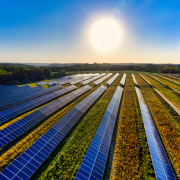AgriSolar News Roundup: Pollinators Thrive in Agrisolar, German Agrivoltaics Testing, Argonne Agrivoltaic Research, Duke Floating Solar Farm, Solar Saffron in Vermont, Agrisolar Project in Iowa
Argonne Study Shows Insect Populations Tripled in Five Years at Agrisolar Sites
“Researchers at the U.S. Department of Energy’s (DOE) Argonne National Laboratory and National Renewable Energy Laboratory wanted to understand the ecological value of PV solar energy sites planted with native grasses and wildflowers. They examined how vegetation would establish and how insect communities would respond to the newly established habitat. The five-year field study looked at two solar sites in southern Minnesota operated by Enel Green Power North America. Both sites were built on retired agricultural land.
The two studied solar sites were planted with native grasses and flowering plants in early 2018. From August 2018 through August 2022, the researchers conducted 358 observational surveys for flowering vegetation and insect communities. They evaluated changes in plant and insect abundance and diversity with each visit.” anl.gov
This research study was conducted by AgriSolar Clearinghouse partners as well as Argonne and NREL.
Agrivoltaics Testing on Former Opencast Mine
“German energy company RWE announced it completed a 3.2 MW agrivoltaic project on a 7-hectare recultivation area on the edge of the Garzweiler opencast mine near Bedburg, a town in the Rhein-Erft-Kreis district of North Rhine-Westphalia, Germany.
The utility said it will test three different agrivoltaic system designs for different crops on both arable and horticultural land at the facility over five years. The aim is to develop suitable management methods and value-adding operating concepts for agrivoltaic systems.” – PV Magazine
New Research Shows Solar Panels Benefit Habitats and Farms
“Argonne researchers have concluded a five-year study of two agrivoltaic arrays in Minnesota, where the agrivoltiacs movement is particularly strong. They have just published the results of their study in the open access journal Environmental Research Letters.
By the end of the field campaign, the team observed increases for all habitat and biodiversity metrics. There was an increase in native plant species diversity and flower abundance. In addition, the team observed increases in the abundance and diversity of native insect pollinators and agriculturally beneficial insects, which included honeybees, native bees, wasps, hornets, hoverflies, other flies, moths, butterflies and beetles.” – Cleantechnica
Duke’s Florida Solar Farm Now Online
“Duke Energy is piloting a floating solar farm in Florida – its first – on an existing cooling pond in Polk County.
The almost 1-megawatt (MW) floating solar array features more than 1,800 solar panels that float on top of two acres of the water’s surface on the pond – which used to be a phosphate mining pit – at the Duke Energy Hines Energy Complex in Bartow, southeast of Lakeland. It provides enough clean electricity to power around 100 local households.” – Electrek
Vermont Agrivoltaic Project Includes Saffron
“The foundation for the new agrivoltaic project was laid by saffron expert Arash Ghalehgolabbehbahani of the University of Vermont’s North American Center for Saffron Research and Development, along with researchers Bruce L. Parker and Margaret Skinner.
The choice of Vermont for this particular project is no accident. Researchers at the University of Vermont have been pitching saffron cultivation as a way to help specialty crop farmers stay in business and preserve cultivated land for future generations. The agrivoltaic program was inspired by the success of a previous saffron cultivation conducted by the school.” Cleantechnica
Alliant Energy Develops Agrivoltaic Research Project in Iowa
“A multi-disciplinary team of ISU professors, graduate and undergraduate students is working with Alliant Energy through a public-private partnership to study the potential of agrivoltaics, the simultaneous use of areas of land for both solar panels and agriculture. The team includes horticulturalists, economists, environmentalists, sociologists, engineers and even entomologists.
The project is the first of its kind. ‘There has been research conducted, but not on a utility scale,’ says Nick Peterson, Strategic Partnerships Manager with Alliant Energy, ‘and not in a public/private partnership with a land grant university.’” – Modernfarmer



